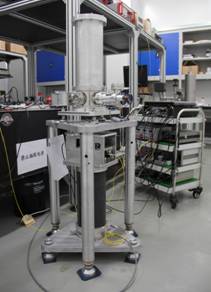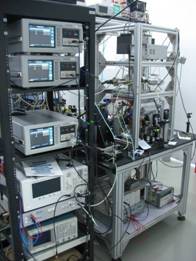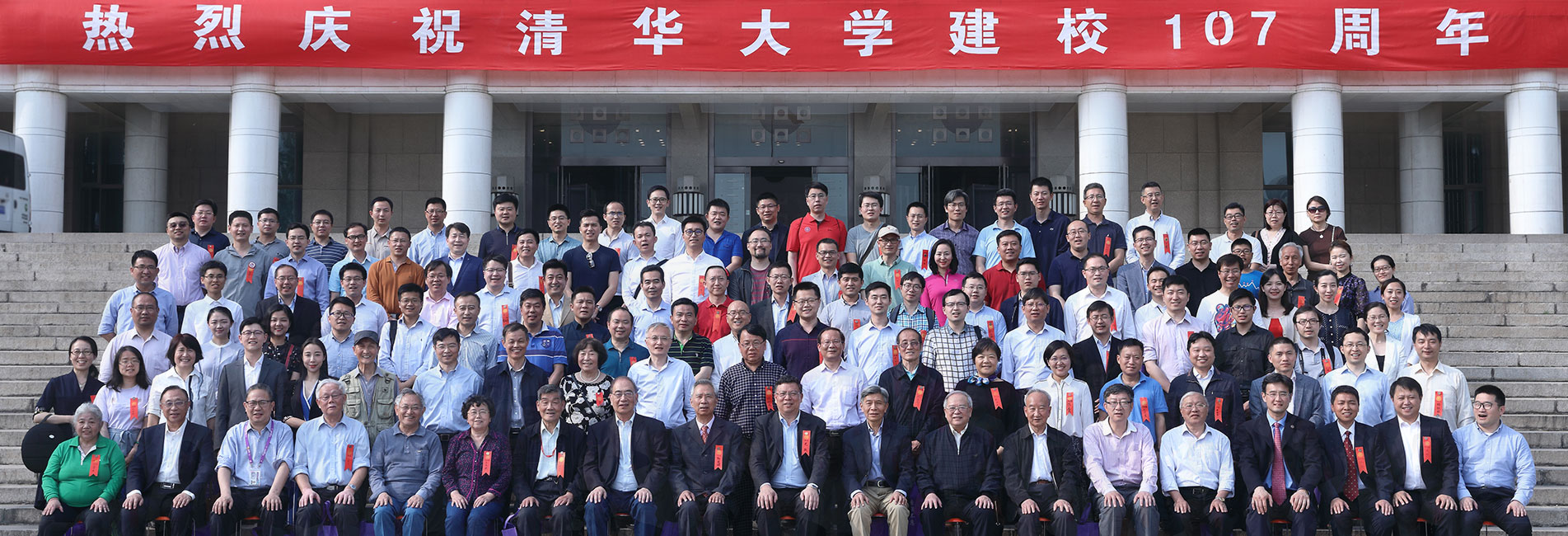The Joint institute for Measurement Science (JMI) is established by the National Institute of Metrology of China and Tsinghua University. The research area is focused on precision instrumentation for the measurement of time & frequency, earth gravity, rotation and magnetic field.
(1) Absolute gravity measurement
Absolute gravity measurement is a very important approach to explore the gravitational information of the earth. Because of the significant applications in geodesy, seismology, and mineral exploration, various absolute gravimeters with different principles were developed during 1980’s to 1990’s [1]. With the construction of ‘2000 national gravity network’ and ‘China crustal motion observation network’, high precision gravity measurements are increasingly required. In order to further investigate the possible uncertainty of high precision absolute gravity measurement, and satisfy the requirements of national gravity observation, we developed the T-1 high precision absolute gravimeter.
The T-1 gravimeter adopts classic free-fall scheme to measure the local gravity value. The system consists of several parts: high vacuum free-fall chamber, frequency-stabilized laser interferometer, low-frequency vertical vibration isolation, high-speed real-time signal acquisition, instrument control and data processing [2]. Measurement results give a precision of 1 µGal in a typical observation within 12 h, and the combined standard uncertainty is about 6 µGal.

Fig. 1 The T-1 gravimeter at the JMI lab
(2) Microwave atomic clock based on cadmium ions
The frequency stability of this atomic clock is expected to 2×10-14 τ-1/2 thanks to the techniques of ion trapping and laser cooling which greatly reduce the Doppler frequency shift and improve the interaction time between the ions and the radiation field. Because this atomic clock system is relatively simpler than other atomic clocks based on cold atoms or ions, it is feasible to build a transportable atomic clock with competitive performance. The transportable microwave atomic clock based on cadmium ions will be applied widely in the field of precision measurement, for example, precision comparison between two atomic clocks in different locations.
This project was carried out in the December of 2010. So far, we have finished the assembling of ion trap, ions trapping and detection, ion temperature measurement, the detection of clock signal and the measurement of the frequency of the clock transition [3, 4]. Recently, we are focusing on optimizing the parameters of experimental system and preparing the close-loop operation as an atomic clock

Fig. 2 The atomic clock based on cadmium ions
(3) Optical clock based on Ba and In ions
Compared with the microwave frequency standard, the optical frequency standard has higher carrier frequency which will greatly improve the accuracy of atomic clocks. Consequently, it is the cutting edge of international frequency standard research field. We use the electric quadrupole transition ( 6S1/2 F=2 mF=0→5D3/2 F’=0) of the 137Ba ions work as the clock transition. Its wavelength is 2051.8207 nm, and has a 2 mHz spectral width in theory. Using the optical CPT detecting method proposed by us, the bottleneck problem of the single-ion optical frequency standard (low signal to noise ratio) can be solved, while providing a continuous measurement of the optical frequency.
Cold barium ion crystals have been trapped in the linear ion trap. We experimental measured the micro-motion amplitude and speed of ions in the different position of ion trap, and the experimental results will supply a quantitative reference to assess the systematic error of the optical clock. Using LED, we have realized the isotopic selective photo ionization of barium atoms, and different isotopic barium ion crystals can be trapped [5].
For optical clock based on In ion. We use the transition (5s2 1S0→5s5p 3P0) of the 115In ions work as the clock transition. Its wavelength is 236.5 nm, and has a 0.8 Hz spectral width in theory. At present, we have finished the assembling of sub-hertz stable laser system and the optical frequency comb. A new linear ion trap is building up. With the sympathetic cooling method we proposed, the In ion used for clock transition detection can be sympathetically cooled by its neighbor laser cooled In ions. And the fluorescence of them can be distinguished by our self-made high resolution imaging system.
(4) Precise and continuous time and frequency synchronization
The synchronization of time and frequency between remote locations is crucial for many important applications of frequency standard and in modern astronomy. Conventional time and frequency dissemination systems often use satellite links, and normally give frequency transfer stability on the order of 10-15/day with time transfer precision of about a nanosecond. With significant progresses on the stability of atomic frequency standards, conventional methods can no longer fulfill the much higher requirements of frequency comparison and time synchronization. Owing to their properties of low attenuation, high reliability and continuous availability, ubiquitous fiber communication networks have become an attractive option for long distance dissemination of time and frequency signals. We have demonstrated accurate time and frequency dissemination system via an 80 km communication fiber link between Tsinghua University and the National Institute of Metrology of China. Using a 9.1 GHz microwave modulation and a timing signal carried by two continuous-wave lasers, and transferred in the same 80 km urban fiber link, frequency transfer stability at the level of 5×10-19/day is achieved. Time synchronization at the 50 ps precision is also demonstrated [6]. The system is reliable and has operated continuously for several months.
(5) Cold atom interferometry and its applications in ultra-high precise inertial sensing
Atom Interferometry is one of research frontiers in precise measurement fields, which can find applications such as ultra-high precision inertial navigation, measurement of fine-structure constant, gravity wave detection and Geodynamics( e. g. monitoring earthquake or water bed). We are building up a high sensitive cold atom interferometer for high precision inertial sensing. We also have research interests on new atom optical devices based on Bose-Einstein condensed gas (BEC) and optical lattice.
We have built up a Raman atom interferometer based on 87Rb atoms and cold atomic beam [7,8]. The stable cold atomic beam has been prepared successfully, and interfere signals have been observed. The next step is the optimization of the experimental setup for rotation measurement. The setup has a prediction of rotation measurement in short-term sensitivity of ~10-9rad/s/Hz1/2.
(6) High precision absolute magnetometry
High precision absolute magnetometer can work as a standard for metrology, as well as precision instruments for observing and monitoring earth magnetic dynamics, detecting magnetic abnormality in applications such as medicine, mineral and oil exploration, contraband and explosives detection, underwater target detection, geomagnetic matching navigation, earth magnetic mapping, etc.. We are working on a new absolute magnetometer based on atom optics for high accuracy vector magnetic field measurement.
We have designed an absolute magnetometer based on atom optics. The experimental vacuum system has been finished and the magnetic field experiments are ongoing.
Representative Publications (2009- present)
[1] H Hu, S Svitlov, C Rothleitner, J Schaefer, J Zhang, L J Wang. Improvements of the MPG-2 transportable absolute ballistic gravimeter. Metrologia 47 (2010) 575.
[2] Hu Hua, Wu Kang, Shen Lei, Li Gang, Wang Lijun. A new high precision absolute gravimeter. Acta Phys. Sin., 61(2012), 099101.
[3] Wang ZhengBo, Wang ShiGuang, Zhang JianWei, Wang LiJun, Ion storage, cooling and applications in quantum frequency standards, Scientia Sinica Physica, Mechanica & Astronomica, 41(2011): 350-355.
[4] Zhang Jian-wei, Wang Zheng-bo, Wang Shi-guang, Miao Kai, Wang Bo, Wang Li-jun, Progress Towards A Microwave Frequency Standard Based on The Laser Cooled 113Cd+ Ions, in Processings of the 2012 IEEE IFCS, 2012.
[5] B. Wang, J. W. Zhang, C. Gao, L. J. Wang. Highly efficient and isotope selective photo-ionization of barium atoms using diode laser and LED light. Optics Express, 19 (2011), 16438.
[6] B. Wang, C. Gao, W.L. Chen, J.W. Zhang, Y.Y. Feng, T.C. Li, and L.J. Wang. A 10-18/day Fiber-Based RF Frequency Dissemination Chain, in CLEO: 2012 (Optical Society of America, Washington, DC, 2012), CTh4A.3.
[7] X. Wang, Y. Feng, H. Xue, and Z. Zhou, A cold 87Rb atomic beam, Chinese Physics B, 20(2011): 126701
[8] Feng Yan-Ying, Zhu Chang-Xing, Wang Xiao-Jia, Xue Hong-Bo, Ye Xiong-Ying, and Zhou Zhao-Ying, Characterization of a velocity-tunable 87Rb cold atomic source with a high-speed imaging technology, Chinese Physics B, 18(2009): 3373-3378.

